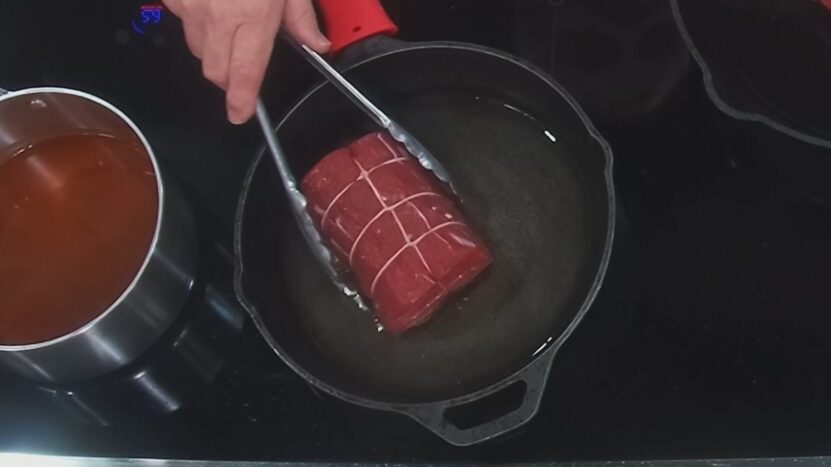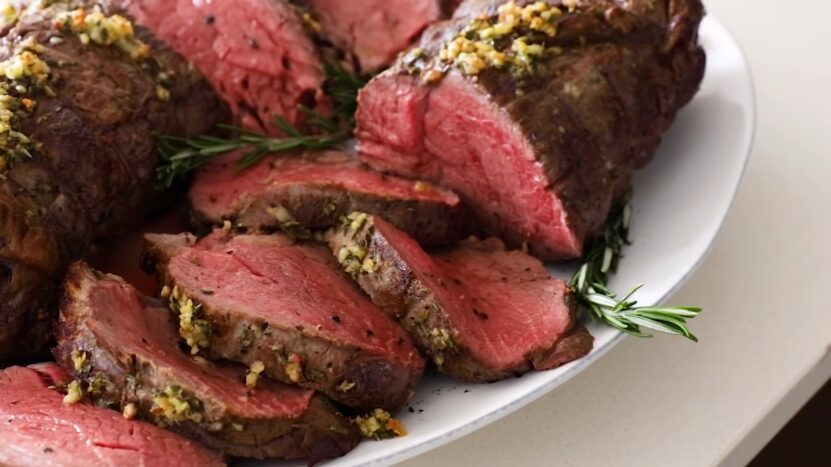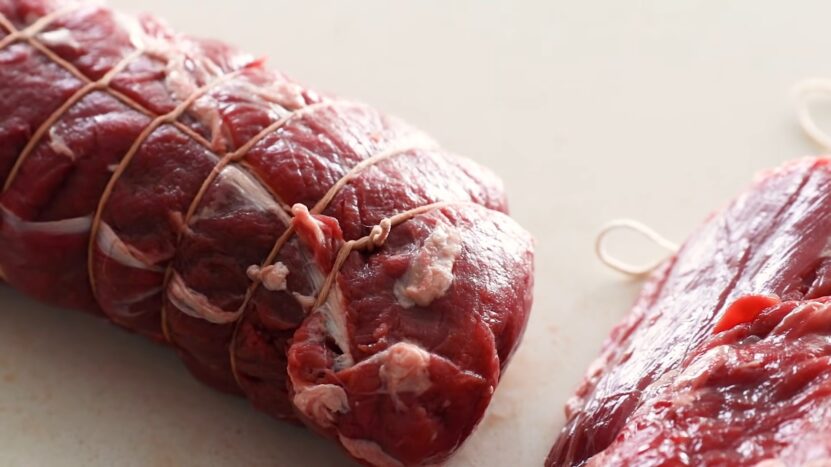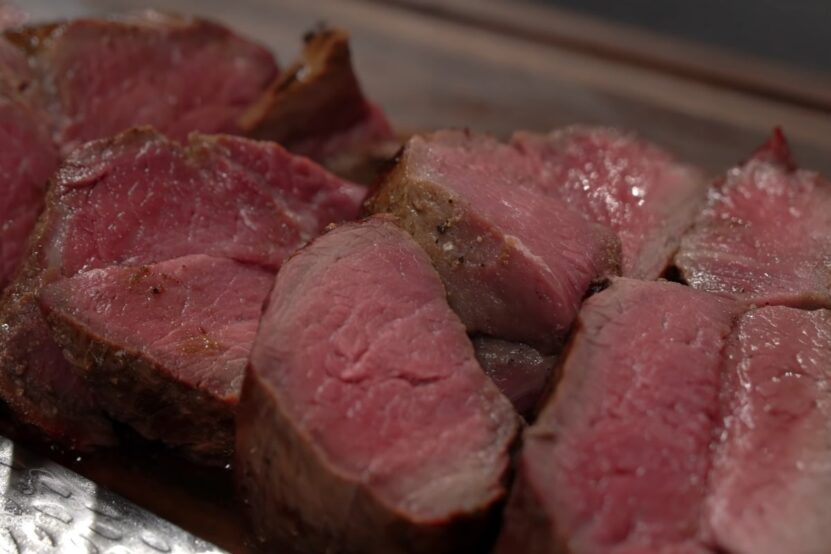Beef tenderloin: It’s a dish that screams elegance and taste. Whether you’re hosting an intimate dinner or planning a grand feast for a larger crowd, this guide will walk you through the art and science of cooking this prized cut of meat to perfection. Ready to impress your guests and tantalize their taste buds? Let’s get started!
The Basics
Beef tenderloin is considered the crème de la crème of beef cuts, known for its tenderness and rich flavor. Whether you’re a cooking novice or an expert, this guide will help you navigate through the ins and outs of buying, prepping, cooking, and serving beef tenderloin.
What is
Beef Tenderloin
Beef tenderloin is a muscle within the loin, specifically between the sirloin and the rib. It doesn’t get much exercise, which is why it’s incredibly tender. The premium price reflects its high quality, so when you’re making tenderloin, you’ll want to make sure you’re doing it right to get the most bang for your buck.
Why Choose It?
- Tenderness: The muscle fibers are soft, making it a tender cut.
- Flavor: It has a subtle, buttery flavor that is best enhanced with simple seasonings.
- Versatility: From roasts to steaks, this cut offers multiple cooking options.
Choosing the Right Cut

Selecting the best piece of beef tenderloin is crucial for the success of your dish. Learn how to pick the right cut and understand the terms you’ll encounter in the meat aisle.
Grades of Beef
There are different grades of beef tenderloin based on marbling, color, and texture. The USDA grades are Prime, Choice, and Select. While Prime offers the best marbling and tenderness, Choice is a more affordable option without significantly compromising quality.
Size and Portioning
A whole beef tenderloin can weigh anywhere between 4 and 7 pounds and can serve about 8 to 12 people depending on the portion size. When buying, consider:
- Weight: Calculate around ½ to ¾ pound per person for boneless tenderloin.
- Length: Check that it fits in your cooking vessel.
- Uniformity: Ensure the cut is as uniform as possible for even cooking.
Preparation Techniques

Preparing beef tenderloin involves a few crucial steps. From trimming the fat to marinating or seasoning, preparation ensures that the meat cooks evenly and absorbs flavors well.
Trimming and Tying
Trimming removes the “silver skin,” a fibrous layer that can be tough when cooked. After trimming, you may also tie the tenderloin at intervals to make it uniformly round for even cooking.
To Marinate or Not to Marinate
Beef tenderloin has an inherently rich flavor that often requires little more than salt, pepper, and perhaps some garlic for seasoning. However, if you wish to marinate it, keep these points in mind:
- Duration: A couple of hours or overnight for more flavor penetration.
- Ingredients: Acidic elements like wine or lemon juice can tenderize the meat further.
Cooking Methods

Now that your beef tenderloin is prepped and ready, it’s time to cook it. Let’s explore various methods suitable for both small and large gatherings.
Roasting
Roasting is the most common method for cooking beef tenderloin, particularly for larger crowds. The process usually involves searing the meat first to lock in the juices, then slow-roasting in the oven.
- Temperature: A low heat, around 325°F, is ideal.
- Time: Roughly 10 minutes per pound for medium-rare.
Grilling
Grilling is an excellent option when cooking individual tenderloin steaks or smaller pieces of meat. It offers that smoky flavor that many people love.
- Temperature: High heat for searing, then medium heat for cooking.
- Time: About 5–7 minutes per side, depending on thickness.
Serving Suggestions

Presentation is almost as important as preparation. A beautifully presented beef tenderloin not only looks appealing but also enhances the dining experience.
Side Dishes
- Potatoes: Mashed, roasted, or au gratin.
- Vegetables: Grilled asparagus, steamed green beans, or a colorful salad.
- Sauces: A classic béarnaise, a red wine reduction, or a simple horseradish cream.
Wine Pairing
A beef tenderloin pairs wonderfully with red wines that have good acidity and moderate tannins, like a Cabernet Sauvignon or a Bordeaux blend. The richness of the meat balances the acidity of the wine, making for a harmonious dining experience.
Scaling for a Crowd
Cooking beef tenderloin for a large crowd can seem intimidating, but with a few tips, you can manage it without breaking a sweat.
Pre-Cooking Tips
- Advance Preparation: Trimming and seasoning can be done a day in advance.
- Cooking Vessels: Make sure your roasting pans or grills can accommodate the size.
Cooking and Serving Logistics
- Cooking in Batches: For extremely large crowds, consider cooking in smaller batches to ensure even cooking.
- Resting Time: Allow for adequate resting time (at least 15 minutes) before slicing to retain juices.
Cooking Tools You’ll Need

Equip yourself with the right tools for a stress-free and efficient cooking experience. The appropriate cooking tools can significantly enhance the quality of your beef tenderloin.
Basic Tools
- Sharp Knife: For trimming and slicing.
- Kitchen Twine: For tying the meat to help it keep its shape.
- Meat Thermometer: An absolute must for getting the perfect internal temperature.
Advanced Tools
If you’re feeling a bit more adventurous and want to take your beef tenderloin to the next level, you might consider:
- Sous-vide Machine: For unparalleled precision in cooking.
- Smoker Box for Grill: To infuse a smoky flavor if you’re opting for the grill.
Mistakes to Avoid

Even the most experienced cooks can make mistakes. However, being aware of common pitfalls can help you steer clear of them and ensure that your beef tenderloin turns out perfect.
Overseasoning
The subtle, buttery flavor of beef tenderloin can easily be overwhelming. It’s tempting to go overboard with strong marinades or spice rubs, but often, less is more.
Overcooking
Because of its lean nature, beef tenderloin can dry out quickly. Overcooking not only impacts the tenderness but also mutes the natural flavors. Always use a meat thermometer to avoid this mistake.
FAQs
Can I cook beef tenderloin from frozen?
It’s not recommended to cook beef tenderloin from a frozen state as it can result in uneven cooking. The exterior may become overcooked while the interior remains undercooked. For the best results, thaw the meat in the refrigerator for at least 24-48 hours before cooking.
Is it necessary to sear beef tenderloin before roasting?
Searing is optional but beneficial. It helps to lock in the juices and adds a flavorful crust to the exterior of the meat. If you’re short on time or prefer a simpler preparation, you can skip this step, but the end result may lack that extra layer of flavor and texture.
What are the signs that my beef tenderloin is done resting?
Resting allows the juices to redistribute throughout the meat, resulting in a juicier cut. A good rule of thumb is to let the meat rest for at least 10–15 minutes. You’ll know it’s done resting when the juices have mostly stopped flowing and the meat has slightly cooled, making it firmer and easier to slice.
Can I use an electric carving knife to slice the beef tenderloin?
While you can use an electric carving knife, many chefs prefer a sharp, high-quality manual carving knife for more control over the thickness of each slice. Electric knives can sometimes shred the meat, diminishing the presentation and texture.
How do I store leftover beef tenderloin?
Leftover beef tenderloin should be stored in an airtight container in the refrigerator and consumed within 3–4 days for best quality. If you need to store it for a longer period, consider freezing it in vacuum-sealed bags for up to 2–3 months.
Can I cook beef tenderloin ahead of time for an event?
Yes, you can cook beef tenderloin ahead of time, but it’s advisable to undercook it slightly if you plan on reheating it. Keep in mind that reheating can cause the meat to lose some of its original tenderness and flavor. To minimize this, reheat it in a low-temperature oven (around 275°F) covered in foil to retain moisture.
Final Words
Whether it’s a special occasion or a weekend dinner, beef tenderloin is sure to wow your guests. From selection to preparation and presentation, each step is a building block to culinary excellence. So go ahead, roll up your sleeves, and create a masterpiece your guests won’t forget!
